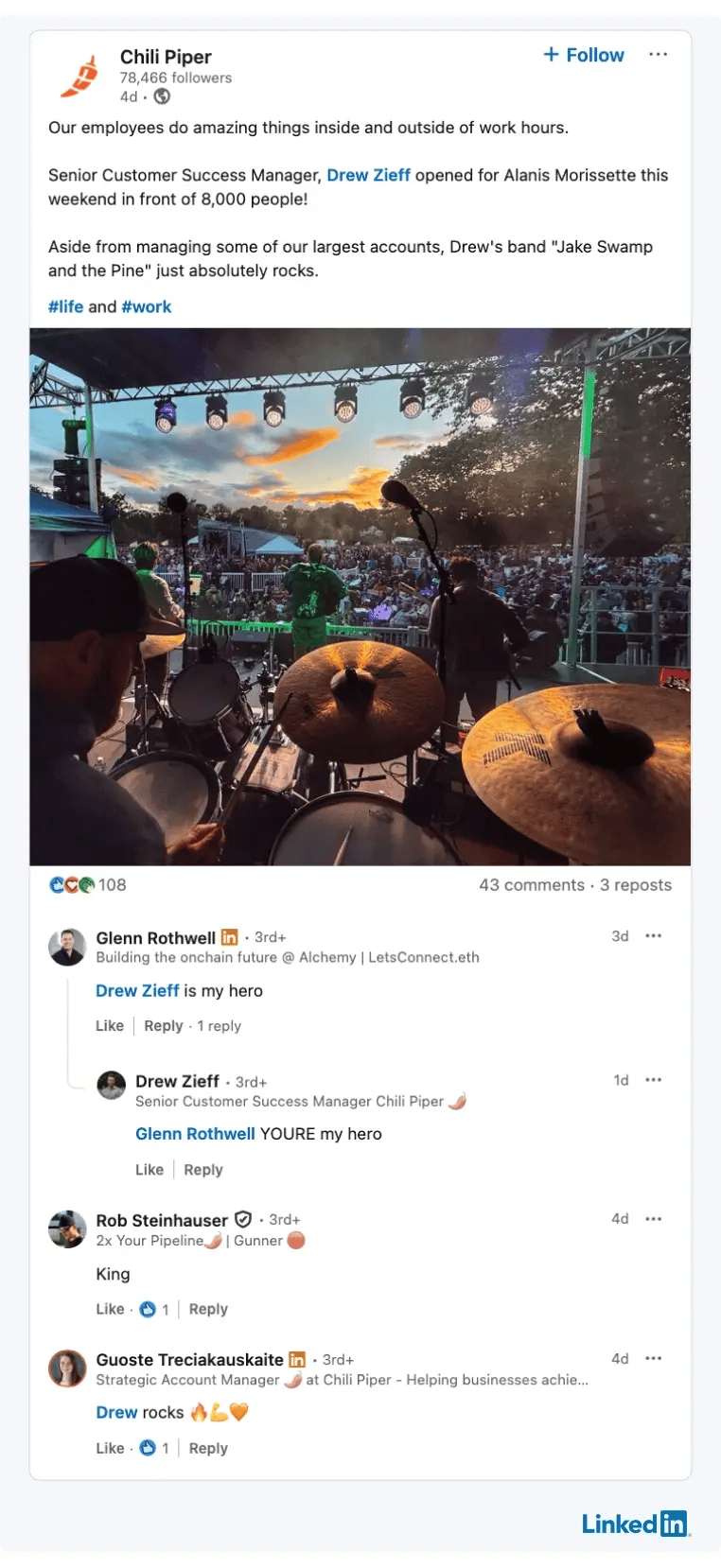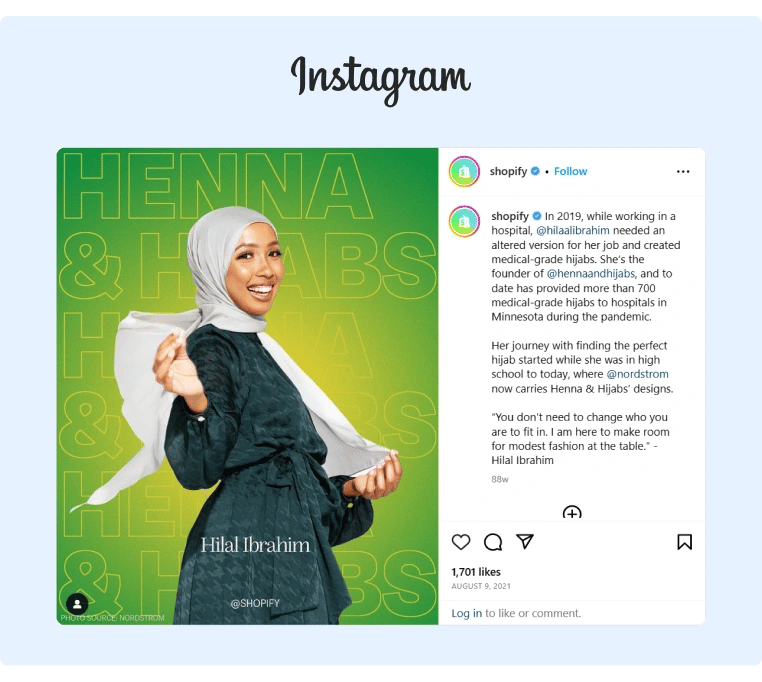3. Involve Executives in Content Amplification Efforts
Your executives probably have the most influence, so ask them to share relevant content by creating their own posts about company news or sharing company content on their social profiles.
This content amplification technique is highly effective because people naturally trust content from their friends and thought leaders more than branded content. In addition, social algorithms are also more likely to give personal accounts more reach.
Rand Fishkin is a great example of an executive who consistently uses his personal profile to promote the audience research tool, SparkToro.
As a result, his posts typically get more engagement, and they don't feel like traditional advertising. Even if you don't purchase the tool, you still walk away with some new, helpful insights. (But you can also see how his tool makes it easier to accomplish the goal!)
The trickiest part about this content amplification strategy is that many company executives are busy and don't have time to create thoughtful social media posts.
Fortunately, GaggleAMP can solve this.
You can create an engagement activity and even pre-write a post for the executive.
For example, if you're announcing an acquisition, funding round, or any other newsworthy event, you can create a pre-written post or use the AI-Powered Paraphrase feature to approve and publishing unique content.
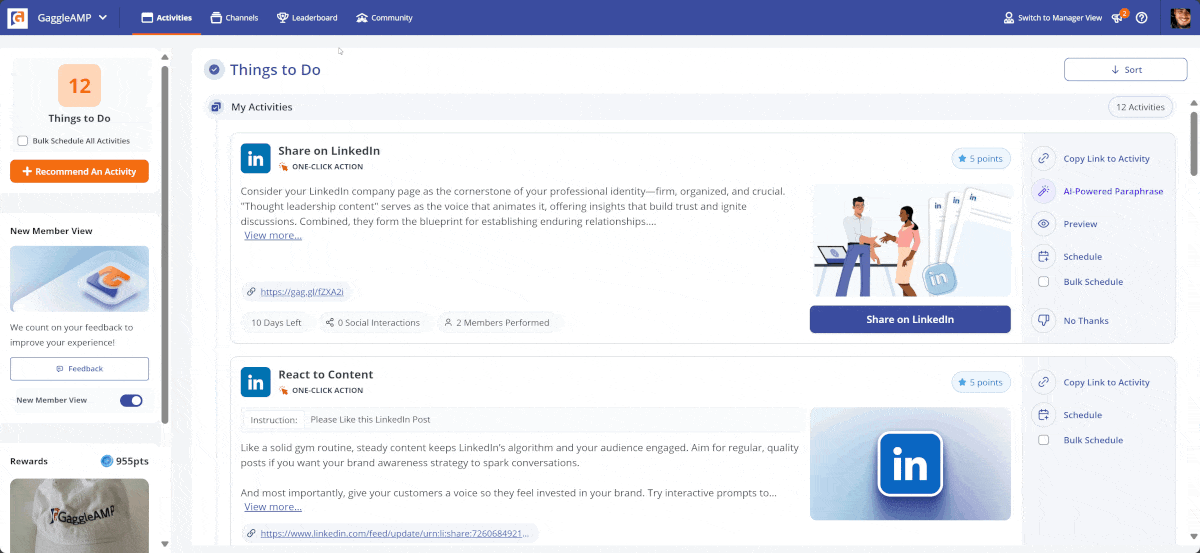
However, if you want the post to be written in their own words or have them provide their unique viewpoint on an event, you can use the 'Question' engagement activity.
This makes it easy to keep even the busiest executives engaged.
4. Collaborate With Influencers
If you're trying to reach new audiences, collaborate with influencers that already have their attention.
While the most common strategy for B2C brands is paying influencers for a post, most B2B influencers aren't open to traditional paid campaign partnerships. However, there are plenty of other ways to organically partner with B2B influencers, like:
-
Live streaming joint webinars or podcast episodes to your brand's social media account.
-
Cross-promoting content with parallel brands.
-
Providing shoutouts to parallel brands.
-
Forming affiliate relationships with other brands.

While this is a super easy tactic that might get some exposure, doing a more collaborative engagement (like a joint podcast episode) will probably work even better.
Here’s a great example of how Ross Hudgens, the founder of an SEO agency, interviewed SEO expert Eli Schwartz on why startups should not do SEO.
It generated 27 comments from both Eli and Ross’s followers, which helped both of them enjoy a significant boost in engagement.
5. Engage With Your Audience
Responding to every person's comment is the easiest way to double your engagement rate (which can help you earn even more organic reach from social media algorithms). To take it up another notch, answer that person's question with another question to keep the conversation going.
Neil Patel is excellent at engaging with his commenters.
Here's a screenshot of the comments section from a recent video about TikTok vs YouTube that he shared on LinkedIn. You can see that each response is conversational and organic – exactly what social media algorithms want.
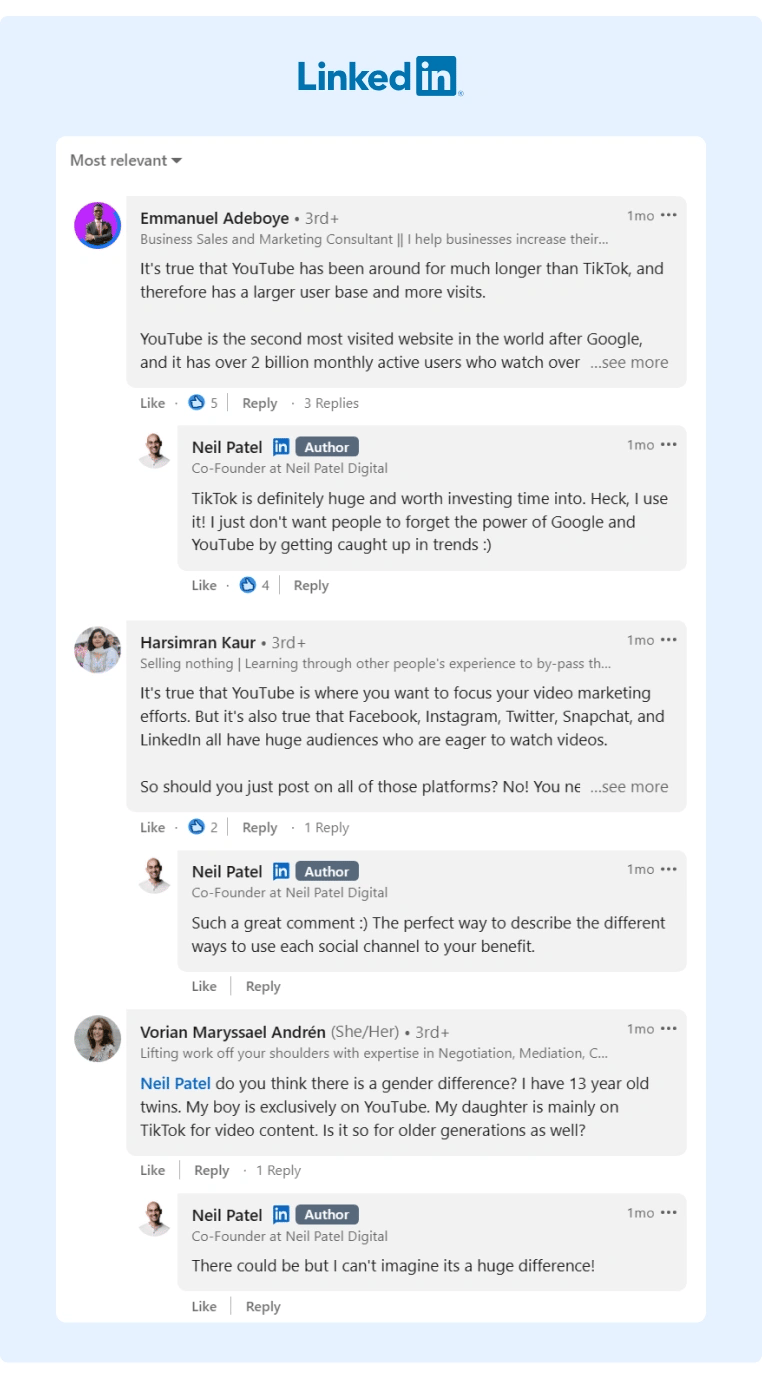 Source: Neil Patel
Source: Neil Patel
I’m guessing that Neil Patel probably has someone else monitoring the comments on his social media profile. Even if you don’t have time to answer questions yourself, you can hire an assistant to do it for you.
Another engagement tactic is to use a social listening tool to track relevant keywords and alert you when someone mentions them. Then, you can jump into the conversation and organically add value.
6. Participate in Groups
While most groups don't welcome blatant promotion, sharing key things you've learned and answering people's questions are great ways to earn new followers from the group.
For example, someone in a design group was asking about a particular font family, and this person wrote out a thoughtful comment that answered the question:
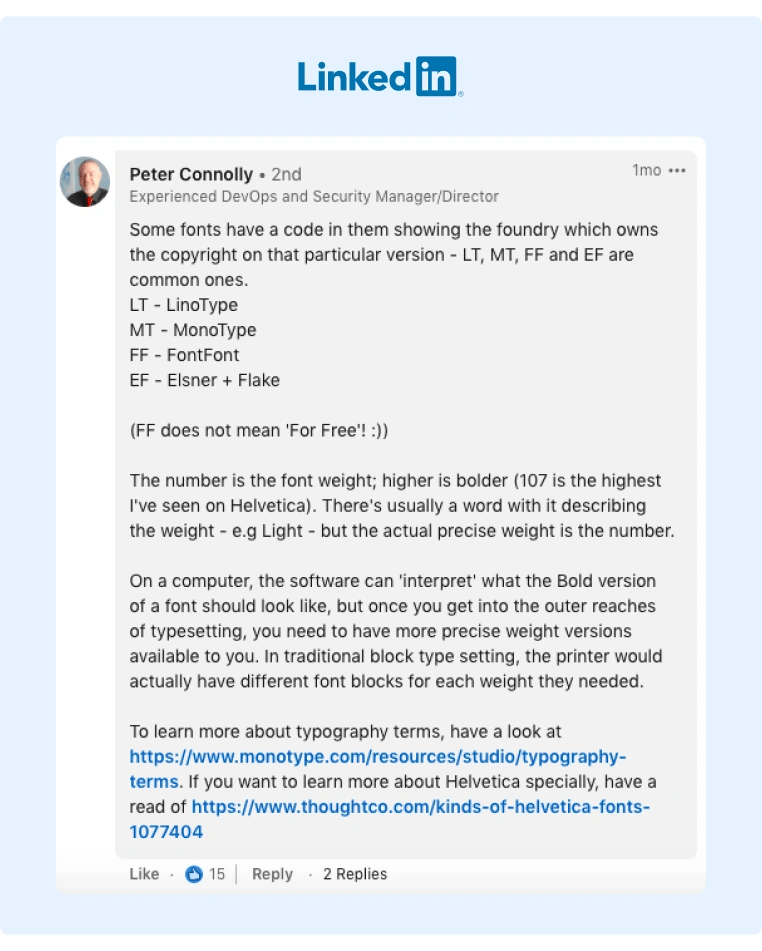
This builds trust, and the person will probably follow you if your response is insightful and helpful.
As you can see, an effective social campaign isn't just about posting more content. Often, achieving your business goals is as simple as organically engaging with prospects and influencers.
Creative Content Ideas to Drive Organic Engagement
Great strategies stall when content runs dry. Even the most structured publishing plans can hit a wall if idea generation becomes a scramble. For B2B marketers juggling multiple channels, this often leads to sporadic posting and missed opportunities to engage an audience primed for value—not volume.
The fix isn’t more content. It’s better content, delivered in formats that match how your audience consumes, reacts, and shares. Here are four B2B social media content ideas that consistently generate engagement while staying true to brand voice and buyer expectations:
-
Team Spotlights
Showcase employees with “day-in-the-life” carousels or short-form videos. Not only does this humanize your brand, it invites internal resharing—extending organic reach.
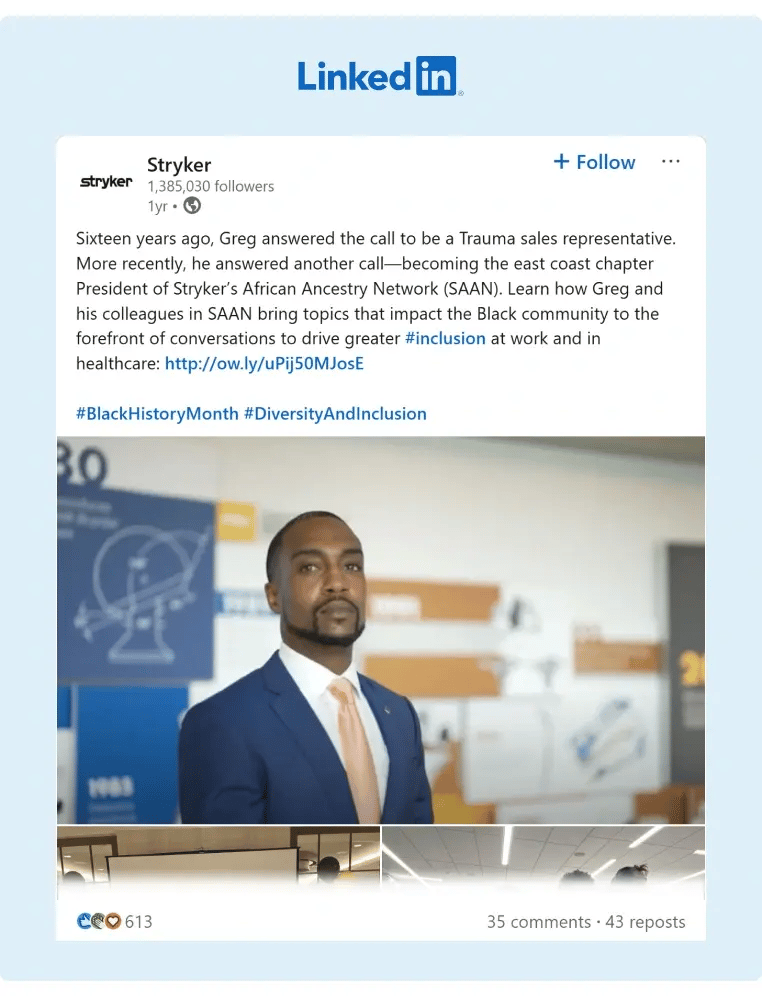
-
Customer Proof Points
Visual testimonials, before/after metrics, or short LinkedIn quote graphics reinforce credibility without needing a full case study. -
Interactive Formats
Use polls, carousel sliders, and native video snippets to increase dwell time and surface content in more feeds via platform algorithms. -
Behind-the-Scenes Access
Share Slack screenshots (with permission), project wins, or product roadmap sneak peeks. These offer transparency and build trust in the decision-making process.
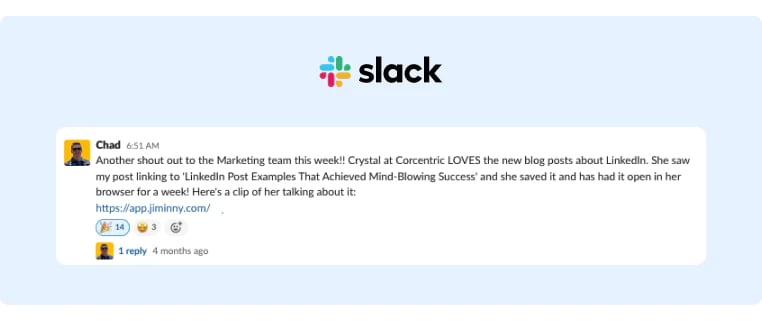
These content types work because they hit both engagement triggers and psychological drivers: familiarity, relevance, and low friction. People are more likely to like, comment, or share when the content feels relatable, speaks to their role, and requires minimal effort to consume.
Employee advocacy platforms like GaggleAMP can supercharge this. Once content is created, it can be distributed as bite-sized engagement tasks—enabling employees to personalize and amplify posts through their own networks. It’s a high-leverage way to turn solid content ideas into consistent performance.
Mastering Social Media Communication: Best Practices for B2B Engagement
Hitting “publish” is only half the job. Once your post is live, the conversation begins—and how your brand responds in comments, threads, or DMs carries just as much weight as the content itself. This is where many teams slip. Tone, timing, and etiquette get inconsistent, and suddenly what should be a simple thank-you reply becomes a brand risk.
Strong social media communication best practices create consistency across your team and reduce the chances of missteps. Here's a breakdown of what to do—and what to avoid:
| Scenario | Recommended Response | Avoid This |
|---|---|---|
| Compliment on a post | Acknowledge specifically and tag them | Use a generic "Thanks!" with no name or detail |
| Negative comment | Respond promptly, empathetically, and offline | Delete or argue publicly |
| Confusion/question | Clarify, link to a helpful source | Leave unanswered or use canned, unhelpful replies |
| Industry debate | Contribute thoughtfully without taking sides | Dismiss the topic or post a reactive hot take |
Misaligned messaging in these moments can have outsized effects. A careless reply can erode trust, while inconsistent tone between departments (say, HR vs. Marketing) can confuse audiences and dilute brand identity. It’s not just a communication issue—it’s a brand governance issue.
Clear internal guidelines, tone-of-voice training, and cross-functional alignment are critical. And when social engagement is managed through employee advocacy workflows, like those in GaggleAMP, marketing teams can offer pre-drafted replies, suggest safe language, and even assign platform-specific engagement tasks—preserving both speed and brand safety.
Because in a world where every comment is a micro-impression, communication isn’t just engagement. It’s brand building.
B2B Success on LinkedIn: How to Engage With Purpose
What works on one platform can flop on another. That’s the nuance often lost when B2B marketers default to generic engagement advice. Especially on LinkedIn—where algorithms, professional expectations, and buyer behavior differ drastically from other social environments—success depends on knowing the platform's unwritten rules.
Let’s focus first on LinkedIn. The platform rewards content that drives dwell time and meaningful interactions, not just clicks or reactions. One of the most effective LinkedIn engagement strategies? Start conversations in the comments, not just the post. This could mean posing a question as your CTA, then adding a response in the comments to encourage others to join in. It's a simple way to increase time spent on your content and train the algorithm to boost visibility.

Cadence also matters. Unlike platforms where frequency wins, LinkedIn favors quality and pacing. Two to three high-quality posts per week, spaced for breathing room, often outperform daily posts with minimal traction. And while visuals help, posts with a strong narrative or opinion tend to generate more discussion than overly branded assets.
Here is how LinkedIn Best Practices for B2B compare to generic social tactics:
| Tactic | Best Practice | Generic Social Advice |
|---|---|---|
| CTA Format | Open-ended question with value-add in comments | “Click the link” or “Follow us” |
| Ideal Post Cadence | 2–3x per week, with focus on engagement quality | Daily or more frequent for algorithm reach |
| Comment Strategy | Personal replies, thoughtful questions | Emoji replies or one-word answers |
| Content Type Prioritization | POV posts, leadership content, job culture | Trends, memes, broad inspirational quotes |
For B2B teams, this level of specificity matters. Your buyers are comparing solutions, researching leadership credibility, and watching how you interact—not just what you post. It’s why employee voices tend to outperform branded channels.
Platforms like GaggleAMP make this scalable. Managers can assign engagement tasks tailored to LinkedIn—from comment prompts to content resharing—so employees show up in ways that match the platform’s dynamics. That means a seller can weigh in on a product thread, a recruiter can amplify a hiring post, and a marketer can add context to an industry stat—without needing a daily nudge.
Social media is rarely one-size-fits-all. The strongest engagement comes from treating each platform as a unique stage—and showing up with content and behaviors designed to thrive there.
Social Media Automation Without Losing the Human Touch
Automation is a marketer’s best friend—until it becomes their worst enemy. When overused or misapplied, it can strip the personality out of your brand, making posts feel cold, robotic, or out of sync with current conversations. In B2B, where trust and credibility take time to build, the way you automate matters just as much as what you automate.
The right approach to automation is selective. Scheduling posts? Absolutely. Auto-publishing across platforms? Often efficient. But liking, commenting, or following through bots? That’s where brands start to erode credibility. The line is clear: automate delivery, not dialogue.
For B2B teams exploring social media automation tools, it’s important to look beyond basic scheduling features. The tools that deliver real value offer a blend of efficiency and personalization—like AI-generated captions tailored to voice, CRM integration to trigger content by lifecycle stage, and integrated workflows to reach employees in-platform.
Here’s a simplified framework to apply:
The 3-Part Rule for Automation With Empathy
-
Automate for scale, not substitution. Use tools to expand reach, not replace interaction.
-
Maintain voice consistency. Pre-write copy with platform tone and audience in mind—even if it’s AI-assisted.
-
Keep approvals human. Empower managers to review scheduled content or engagement prompts before they go live.
When done well, automation actually enhances human touch by removing repetitive work—freeing up time for real interaction. And with tools like GaggleAMP, you can assign pre-approved, customizable engagement tasks to employees without ever losing brand control. It’s automation that supports participation, not replaces it.

Because in B2B, automation shouldn’t hide the human behind the brand. It should help them show up more often—and more effectively.
Trends Shaping B2B Organic Social Media in 2025
Organic social is evolving faster than most marketers are prepared for. What once worked—link posts, static graphics, one-way updates—is no longer enough to hold attention or drive measurable impact. As buyer behavior shifts and algorithms favor depth over volume, the most effective brands are adapting their organic strategies accordingly.
Here are the top organic social media trends reshaping B2B in 2025:
-
AI-Assisted, Human-Voiced Content
Marketers are using generative AI to scale production, but layering in human voice and brand POV to keep posts authentic and on-message. -
Short-Form Thought Leadership Video
Micro-videos (30–90 seconds) are becoming key for capturing engagement, especially on LinkedIn where dwell time influences visibility. -
Decentralized Employee Influence
The rise of “employee creators” is shifting reach away from brand handles toward individual profiles—especially among sales, execs, and SMEs. -
Micro-Community Targeting
Instead of broadcasting broadly, B2B teams are leaning into niche groups and influencer micro-networks for contextual engagement. -
Ephemeral Formats for B2B
Temporary content (stories, time-bound carousels) is gaining ground in B2B as a way to create urgency and drive time-sensitive actions. -
Feedback-Driven Content Iteration
Marketing teams are analyzing employee and audience reactions in real time to adapt content formats, tone, and timing dynamically.
Brands that stick to static, one-directional posting calendars built for 2022 will likely see declining engagement, shrinking reach, and less relevance in buying journeys.
Staying ahead of these changes requires not just awareness, but system-level responsiveness. Marketers must translate trend awareness into strategy—and strategy into scalable workflows. And that’s exactly where employee advocacy platforms like GaggleAMP can create competitive advantage, helping teams test, iterate, and distribute trend-aligned content at scale.
Level up Your Organic Social Strategy Now
Having an organic social media presence is invaluable.
It makes it easier to earn trust with potential customers and stay top of mind with existing customers, which directly impacts key KPIs like acquiring new customers. In addition, you'll have a powerful promotion engine whenever you have a new sale, post a new blog post, or need to source more talent.
Of all the tactics mentioned above, we still believe that employee advocacy is the most effective way to grow your organic social media presence. However, most content managers don't realize it's so powerful because they don't have an effective system to assign content and measure results.
If you need a solid employee advocacy platform, request a demo today.



